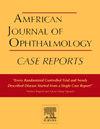Chronic Progressive External Ophthalmoplegia (CPEO): Rehabilitation utilizing scleral contact lenses
Q3 Medicine
引用次数: 0
Abstract
Purpose
To evaluate the use of scleral contact lenses in managing symptoms of Chronic Progressive External Ophthalmoplegia (CPEO) after failed conventional treatments.
Observations
A 69-year-old female with CPEO presented with persistent discomfort and blurry vision despite artificial tears and ointment treatments. Diagnosed with blepharoptosis, myogenic ptosis, dry eye syndrome, dermatochalasis, and lagophthalmos, she showed no improvement post-prolene frontalis suspension surgery. Scleral lenses provided immediate ptosis relief, improving spectacle-corrected visual acuity from 6/12 (−3) and 6/15 (−2) to 6/6 (−1) and 6/7.5 (−2) in the right and left eyes, respectively. Prior to scleral lens fitting, ocular surface staining showed an Oxford score of 3.0 in both eyes, which improved to <1 and remained stable through the four-year follow-up. The OSDI score decreased from 95.83 to 4.17, with sustained symptom relief and stable visual clarity reported throughout, without complications.
Conclusions and importance
Scleral contact lenses provided significant relief from ptosis, markedly improved visual acuity, substantially reduced ocular surface damage, and nearly eliminated subjective dry eye symptoms in this complex CPEO case. These lenses are recommended as a primary therapeutic option for CPEO patients with ocular surface complications when conventional treatments are ineffective, offering sustained symptom relief and enhanced visual function.
慢性进行性外眼肌麻痹(CPEO):巩膜隐形眼镜的康复
目的探讨巩膜隐形眼镜对慢性进行性外眼肌麻痹(CPEO)常规治疗失败后症状的治疗效果。观察一名69岁女性CPEO患者,经人工泪液和软膏治疗后仍出现持续不适和视力模糊。她被诊断为上睑下垂、肌源性上睑下垂、干眼综合征、皮肤松弛症和眼lagmomos,在前额脯氨酸悬吊手术后没有任何改善。巩膜晶状体可立即缓解上睑下垂,将右眼和左眼的眼镜矫正视力分别从6/12(−3)和6/15(−2)提高到6/6(−1)和6/7.5(−2)。在巩膜晶状体植入前,双眼眼表染色显示牛津评分为3.0分,并在4年随访中提高至1分并保持稳定。OSDI评分从95.83降至4.17,症状持续缓解,视觉清晰度稳定,无并发症。结论和重要性:在这个复杂的CPEO病例中,巩膜隐形眼镜能显著缓解上睑下垂,显著改善视力,显著减少眼表损伤,几乎消除主观干眼症状。当常规治疗无效时,这些镜片被推荐作为有眼表并发症的CPEO患者的主要治疗选择,提供持续的症状缓解和增强的视觉功能。
本文章由计算机程序翻译,如有差异,请以英文原文为准。
求助全文
约1分钟内获得全文
求助全文
来源期刊

American Journal of Ophthalmology Case Reports
Medicine-Ophthalmology
CiteScore
2.40
自引率
0.00%
发文量
513
审稿时长
16 weeks
期刊介绍:
The American Journal of Ophthalmology Case Reports is a peer-reviewed, scientific publication that welcomes the submission of original, previously unpublished case report manuscripts directed to ophthalmologists and visual science specialists. The cases shall be challenging and stimulating but shall also be presented in an educational format to engage the readers as if they are working alongside with the caring clinician scientists to manage the patients. Submissions shall be clear, concise, and well-documented reports. Brief reports and case series submissions on specific themes are also very welcome.
 求助内容:
求助内容: 应助结果提醒方式:
应助结果提醒方式:


